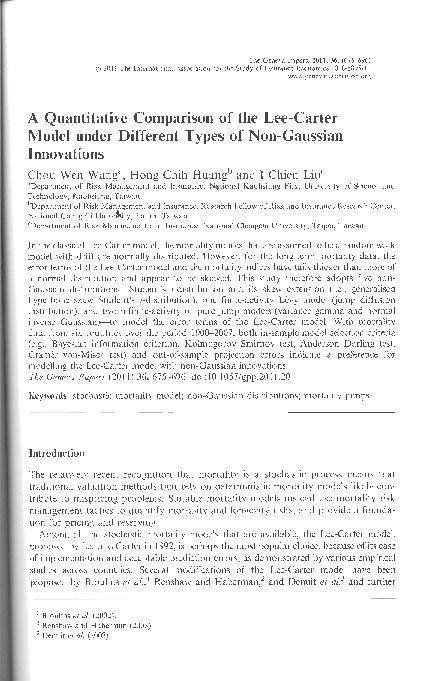A Quantitative comparison of the Lee-Carter model under different types of non-Gaussian Innovations

Contenido multimedia no disponible por derechos de autor o por acceso restringido. Contacte con la institución para más información.
| Tag | 1 | 2 | Valor |
|---|---|---|---|
| LDR | 00000cab a2200000 4500 | ||
| 001 | MAP20110065553 | ||
| 003 | MAP | ||
| 005 | 20111121112840.0 | ||
| 008 | 111110e20111003esp|||p |0|||b|spa d | ||
| 040 | $aMAP$bspa$dMAP | ||
| 084 | $a6 | ||
| 100 | $0MAPA20110028886$aWang, Chou-Wen | ||
| 245 | 0 | 2 | $aA Quantitative comparison of the Lee-Carter model under different types of non-Gaussian Innovations$cChou-Wen Wang, Hong-Chih Huang, I-Chien Liu |
| 520 | $aIn the classical Lee-Carter model, the mortality indices that are assumed to be a random walk model with drift are normally distributed. However, for the long-term mortality data, the error terms of the Lee-Carter model and the mortality indices have tails thicker than those of a normal distribution and appear to be skewed. This study therefore adopts five non-Gaussian distributions Students t-distribution and its skew extension (i.e., generalised hyperbolic skew Students t-distribution), one finite-activity Lévy model (jump diffusion distribution), and two infinite-activity or pure jump models (variance gamma and normal inverse Gaussian) to model the error terms of the Lee-Carter model. With mortality data from six countries over the period 1900-2007, both in-sample model selection criteria (e.g., Bayesian information criterion, Kolmogorov Smirnov test, Anderson Darling test, Cramérvon-Mises test) and out-of-sample projection errors indicate a preference for modelling the Lee-Carter model with non-Gaussian innovations | ||
| 650 | 1 | $0MAPA20080602437$aMatemática del seguro | |
| 650 | 1 | $0MAPA20080592011$aModelos actuariales | |
| 650 | 1 | $0MAPA20080555306$aMortalidad | |
| 650 | 1 | $0MAPA20080555016$aLongevidad | |
| 650 | 1 | $0MAPA20080570590$aSeguro de vida | |
| 700 | $0MAPA20100033678$aHuang, Hong-Chih | ||
| 700 | 1 | $0MAPA20110029364$aLiu, I - Chien | |
| 773 | 0 | $wMAP20077100215$tGeneva papers on risk and insurance : issues and practice$dGeneva : The Geneva Association, 1976-$x1018-5895$g03/10/2011 Tomo 36 Número 4 - 2011 , p. 675-696 |

